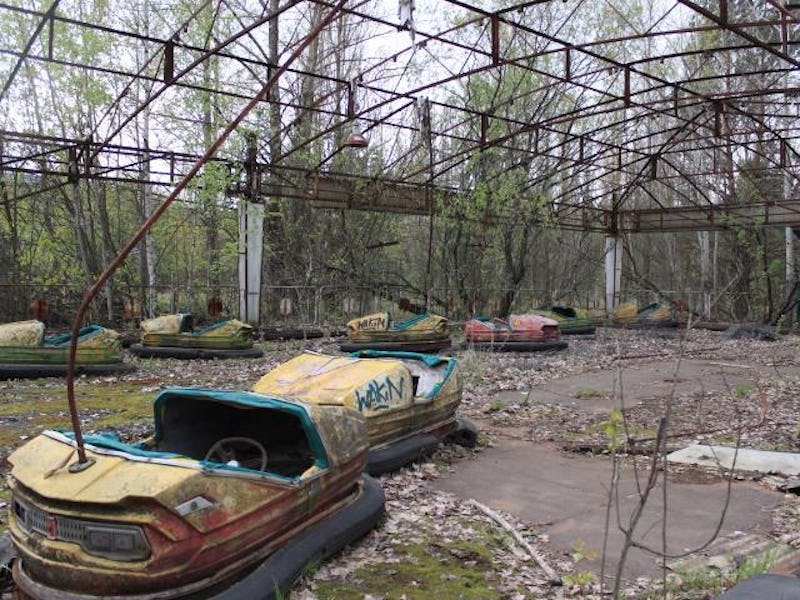"No Good Can Come of Radioactive Fires” in Chernobyl Exclusion Zone
It can't be worse than the original disaster, but it sure wouldn't be good.

Thirty years ago, a massive power surge at the Chernobyl nuclear power plant blasted the top off of a nuclear reactor and sent a massive plume of radioactive smoke, ash, and debris swirling over Central Europe. Three decades later, nature has reclaimed the Chernobyl exclusion zone, abandoned by humans except for the researchers and workers who still brave lingering radiation to work there. Roads and buildings gave way to spindly trees and brush, left dry and barren by rising global temperatures, piling up around the exclusion zone, and underfunded firefighters with outdate equipment fear that the summer could bring massive forest fires throughout the radioactive region.
Christian Borys, a journalist who recently visited the exclusion zone for Al Jazeera, says a summer forest fire could be devastating for both Ukraine and the surrounding countries — even 30 years after the initial meltdown.
“We don’t know exactly how bad any major forest fires could be,” Borys told Inverse. “There’s a general consensus it seems that it would certainly be nowhere near as bad as the accident in ‘86, but a catastrophic fire coupled with the right weather conditions could cause a large plume of radioactive smoke to make its way north and perhaps across Europe.”
The nearby town of Pripyat is completely overgrown with flammable brush.
After the Chernobyl plant blew, the cloud of fallout swept over Northern Europe, reaching as far as Norway’s frozen pastures. When it rained or snowed, the radioactive material came down and leeched into the ground. Lichen and mushrooms sucked it up — and so did the reindeer that ate them. Even today, Radio Free Europe reports that Norwegian reindeer still have to be tested every year for elevated levels of caesium, an element with a radioactive isotope commonly used in nuclear fission.
While much of the radioactive material has decayed, parts of the exclusion zone are still highly radioactive. If a fire starts — and the firefighters Borys interviewed are sure one will — the ash and smoke could carry radiation beyond the exclusion zone all over again.
Borys said there were three large fires last year, and that local sources told him at least two were started by arson. Regardless of the cause, fires would catch quickly in the dry and overgrown cities.
“You walk through the forests of Chernobyl and the trees are all still sitting on the ground and they’re largely intact,” Dr. Timothy Mousseau, a Chernobyl Researcher and professor of biological sciences at the University of South Carolina told Borys for Al Jazeera. “The leaves that fell the previous fall are still sitting there un-decomposed. When it dries out, it becomes a big fire hazard. This fuel load enables the generation of much hotter fires, and potentially catastrophic forest fires.”
A radioactive warning sign stands in front of an overgrown patch of forest.
The firefighters on the ground in Chernobyl are severely under-equipped. Borys said they still use the same model of fire engines and trucks — the ZU-131 AC40 — that they used in 1986 to respond to the initial disaster. Thanks to Ukraine’s ongoing war with Russian-backed separatists, any extra money from the country’s already-stretched budget is funneled east toward the front lines, and the firefighters charged with keeping a major ecological disaster under control, 68 miles from the capital of Kiev, receive little equipment or funding.
Alexander Borovsky, the deputy commander of fire services for the region, told Borys that his force of firefighters struggled to make the best out of what they had.
“We have 300 guys in total, and we work in an area of 2,600 square kilometers [about 1,000 square miles]. The equipment we have is just basic,” Borovsky said in Al Jazeera. “We know there’s no money, so we make do with what we have. We caused this catastrophe as humans and we should care more about another one, but there’s no money.”
Borys said that the effects of a catastrophic fire wouldn’t create the same chaos the initial meltdown did, but would be a massive disaster in their own right.
“My understanding is that we still don’t know very much about how bad the effects were from the accident in ‘86,” he said.
If the exclusion zone were to burn again, Borys said, “It’s not the end of the world, but no good can come from radioactive fires.”